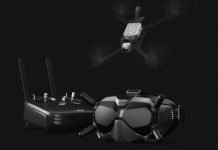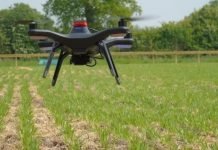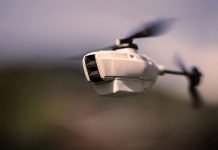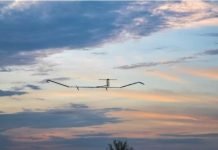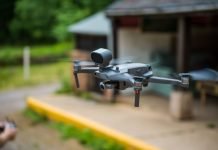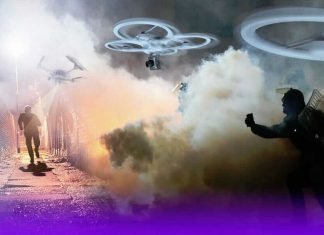
Note: The Phantom 4 Pro is no longer in production.
DJI’s Phantoms are often called “the iPhones of drones” — and that’s a fair description. They’re one of the most popular drones on the planet, packed with high-end features and functionality, and the latest models are always at the top of their class. On top of that, DJI also releases new models at a steady rate, packing even better features into a nearly identical form factor. Case in point? The stellar new DJI Phantom 4 Pro..
Features & Specs
The other standout improvement is the Pro’s camera. The Pro uses all-new hardware with a 1-inch image sensor — which is four times the size as what’s used in the original Phantom 4. On top of that, the camera can shoot 4K video at up to 60 frames per second, and still images at up to 20 megapixels. DJI also tossed in aperture control and a mechanical shutter. No matter how you look at it, the P4’s new camera is bigger, better, and more customizable than ever.
DJI has also added an even more deluxe, optional version, called the Phantom 4 Pro Plus. It’s the exact same drone, but with a controller that has a built-in touchscreen display. It’ll cost you an extra 300 bucks, but you won’t have to connect your phone to the controller with a cable, worry about your smartphone’s battery life, or have your flights rudely interrupted by incoming text messages and calls.
Build Quality & Design
The P4 Pro is nearly identical to the original P4 in terms of both design and build quality. It retains the same hull shape as its predecessor, save for a few minor differences where the new sensors are placed. As such, it’s every bit as strong and sturdy as the P4, which remains among the most attractive and drones available.
It’s impressive that DJI has managed to outfit the drone with so many new features, while still maintaining an identical form factor. The additional sensors have been tucked into the drone’s legs, while infrared and optical sensors are fitted into the drone’s left and right sides. Even the camera, which is drastically better than the one found on the original P4, is just a bit larger than it was before. Unless you familiar with DJI’s drones, the P4 and P4 Pro are as good as identical, despite Phantom’s numerous enhancement.
The only downside to the P4 Pro is that, unfortunately, the Phantom line still isn’t nearly as portable as DJI’s Mavic Pro. The arms and props aren’t designed to fold down, and the landing gear can neither retract, nor be collapsed. It’s not designed with portability in mind — though it’s still small enough to be stuffed inside a backpack if the need arises.
It’s not crash-proof, but it’s close
Battery life and recharge time
Under optimal conditions, DJI says the Phantom 4 Pro can stay airborne for up to 30 minutes — but of course, real-world conditions aren’t always optimal.
To put these claims to the test, we ran the P4 Pro through our usual series of endurance tests. First up was a hover test, where we let the drone hover in place until the battery life became “critically low,” and the drone automatically landed. Our hover test lasted for 28 minutes and 8 seconds — which isn’t very far off from DJI’s claimed 30-minute flight time.
Next, to get a sense of how long P4 Pro will last under more demanding conditions, we recorded the flight times from every other flight test we conducted and averaged everything out. Over the course of 10 different flights that spanned from 100 percent battery charge to the emergency low-battery automatic landing, the Phantom 4 Pro averaged a flight time of 26 minutes and 50 seconds.
While you shouldn’t expect a full 30 minutes of airtime, the endurance is excellent – the best we’ve seen so far. A DJI Mavic Pro lasted 23 minutes and 19 seconds in our hover test, and the Yuneec Typhoon H lasted 23 minutes, 20 seconds. A smaller, more affordable, simpler drone will last far less than any of these. The Hover Camera Passport, for instance, lasted less than 10 minutes.
As for battery recharge times, we found that a nearly-empty battery (around 10 percent remaining) takes about 1.5 hours to juice up to 100 percent. That said, most of the time you’ll be compelled to land before you reach critically low battery levels, so most of our recharges took about an hour and 15 minutes or less. That’s not bad for a cell that offers nearly 27 minutes of airtime. The Yuneec Typhoon H needed over two hours to fill up its tank.
Flight Performance
The flight performance of the Phantom 4 hasn’t changed in this new version. The P4 Pro boasts nearly identical flight specs to the original P4, when it comes to things like speed and agility. Luckily, this isn’t much of a letdown, since the P4 is still among the most nimble quad-blade drones sold.
Speed and agility are basically unchanged in the P4 Pro. Both the P4 and P4 Pro top out at 45 miles per hour (72 kph) — though you can easily reach higher speeds with a good tailwind behind you. It’s not the fastest drone on the market (some can go 55 or even 60 mph), but it’s quick enough for most uses.
However, unlike its predecessor, the P4 can fly up to 31 mph with full multi-directional obstacle avoidance. That’s important. High-speed maneuvers are when you need obstacle avoidance the most. This new model can fly at respectable speeds while also dodging and weaving on its own.
Autonomy
Some of the biggest improvements in the P4 Pro are related to DJI’s new autopilot features. In addition to porting over most of the “standard” autonomous flight modes from the original P4, DJI also borrowed a few of the Pro’s features from the recently-released Mavic, and even added a few extras that we haven’t seen before.
You can set the P4 Pro to orbit a point in space with Point of Interest Mode, repeat flights along a preset path with Waypoints, follow your movements via Follow Me mode, or even adjust the way it responds to joystick control with Course Lock and Home Lock. These modes are included in the Phantom 4, but the Pro version has a couple new tricks up its sleeve: Terrain Follow, Tripod Mode, and a range of new Active Track abilities.
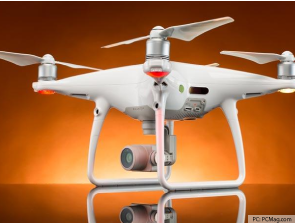
For static shots, the Pro’s new Tripod mode allows you choose a point in space, then keep the drone locked in that position while you shoot – sort of like a flying tripod. In this mode, joystick controls are dampened so that panning/yawing movements are less drastic, and the drone uses a combination of GPS and sensors to hold its position without drifting.
DJI has also added a few updates to its Active Track system. Portrait mode, for example, allows you to track a subject while the drone flies horizontally and matches pace. Spotlight, on the other hand, allows you to lock onto a subject, but allows you to fly the drone in any direction around it. There’s even a 360 mode that will actively orbit any subject you choose, regardless of where that subject might move.
And of course, there’s the new omnidirectional sense-and-avoid system. Using its new sensors, the P4 Pro continually scans the environment around it, and either alerts you when you fly too close to an obstacle, or avoids it autonomously. The best part is that this function can be turned on or off, so it’s there when you need it, but doesn’t get in the way when you want to walk on the wild side and fly close to something.
Our favorite feature, however, is DJI’s new dynamic return to home function. In past generations of the Phantom, when you hit the “return to home’” button, the drone would fly to a predetermined height, then make a beeline straight back to where it took off from. God forbid there were any obstacles in the way — if there were, the drone would smack into them like a blind bird.
When you use the return to home button on the new P4 Pro, the drone will basically retrace its steps and attempt to “reverse” along the same path it used to get where it is — dynamically avoiding any obstacles that might appear along the way, of course. It’s not crash-proof, but it’s close.


